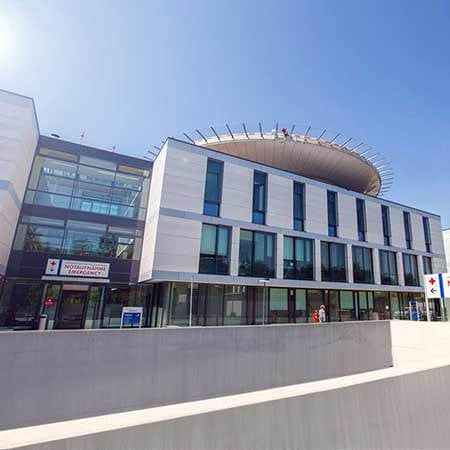A neuroma is one of the most common spinal cord tumors. It is benign and slow-growing, but it causes neurological symptoms, so it must be surgically removed. You can undergo surgery or radiation therapy for your neuroma at a foreign hospital. You are welcome to visit the Booking Health website to see the cost of treatment and choose the most suitable medical care program at a favorable price.
Content
- Principles of spinal neuroma treatment
- Surgical treatment of spinal neuromas
- Radiation therapy for spinal neuromas
- Why to undergo your spinal neuroma treatment abroad?
Principles of spinal neuroma treatment
There are three main options for the management of patients with spinal neuromas. These are the following:
- dynamic monitoring;
- surgical treatment of a spinal tumor;
- radiation therapy.
The tumor can sometimes be found by chance during diagnostics for another disease. Treatment of neurinomas is not required if they are small and do not cause any symptoms. However, patients need constant monitoring that includes a neurological examination and an MRI scan every six months in the first 1-2 years of monitoring, and then annually.
Spinal cord tumor treatment may be indicated if:
- a patient has symptoms;
- the tumor reaches a large size;
- the neoplasm is growing too fast, so there is no doubt that symptoms will manifest themselves in the near future.
The main treatment for spinal neuromas, as for brain tumors in the head, is surgical resection. The objective of the operation is the complete removal of the neoplasm. As a rule, it is possible, but if not, doctors may use only subtotal resection.
Radiation therapy is considered an alternative treatment option. It is less effective, but it gives 75-85% of patients a five-year relapse-free period. Radiation therapy is used in patients for whom surgery is contraindicated, for example, because of severe comorbid heart disease or impaired kidney function.
Surgical treatment of spinal neuromas
Most neuromas are small, non-aggressive, benign tumors with clear borders. They are located within the same spinal segment and do not invade the intervertebral foramen.
Tumors can affect both the anterior and posterior spinal nerve roots. If the posterior (sensitive) roots are affected, surgical resection of the tumor is performed using less traumatic techniques. In standard cases, a laminectomy is performed to approach the spinal cord. During this surgical procedure, doctors remove the vertebral arches. In developed countries, whenever possible, a minimally invasive version of the operation is used, namely a hemilaminectomy as a surgical approach. Doctors remove only one vertebral arch. At the same time, the stability of the spine is maintained since less bone tissue is resected, which speeds up the patient's recovery. Soft tissues are also less damaged, including back muscles and spinal ligaments.
With the anterior location of the neuroma (in the motor nerve roots), a surgical approach may be more traumatic. Doctors have to remove the facet joint, partially or completely.
When performing surgery, doctors remove the neuroma, separating it from normal tissue. The spinal nerve root is preserved if it functions normally. Neurological disorders after surgery are uncommon, even in the case when the spinal nerve root had to be removed.
In about 20% of cases, a neuroma invades the intervertebral foramen (dumbbell or hourglass tumors), and part of it is paravertebral (outside the spine). Depending on the characteristics of growth, there are nine types of such tumors. Moreover, they can be located at different levels, and in each case, a special approach to resection is required. Such tumors are more difficult to remove completely, operations are more complex and traumatic, and a significant amount of bone tissue must be resected. If you have such a tumor, it is best to seek medical attention from a specialized Neurosurgery Center to achieve good treatment outcomes and avoid complications.
Significant difficulties arise in the treatment of patients with a hereditary disease, namely neurofibromatosis type 2. Furthermore, such patients have multiple, large, and more aggressive neuromas. Such tumors often recur after their removal. The neoplasms commonly affect several levels at once. Even in such situations, treatment abroad is effective. In three cases out of four, doctors manage to perform a total resection of all neoplasms.
Radiation therapy for spinal neuromas
Microsurgical tumor resection is considered the standard treatment, and most patients do not require any other treatment after surgery. But in some cases, the operation is contraindicated, undesirable, or too risky. In this case, radiation therapy can be used to locally control the neuroma.
Stereotactic body radiation therapy (SBRT) allows the destruction of a spinal cord schwannoma in one or more sessions. This is an innovative irradiation technique that is very precise and delivers radiation to the tumor from different angles. SBRT is the same as radiosurgery, but the term is used to irradiate targets that are not in the brain.
Irradiation is carried out from many directions, so healthy tissues receive a dose of radiation, but it is insignificant and does not cause any complications. At the same time, all the rays converge on the tumor, as a result of which it receives a large dose of radiation and is destroyed. This does not happen immediately, as the neuroma shrinks over several months or even several years before the final treatment outcome is achieved.
SBRT was first used as an alternative to surgical treatment for benign spinal tumors in the 1990s. The initial treatment regimen involved the use of a dose of 16-30 Gy, which was delivered in 1-5 fractions. This is the same dose used for cancer metastases or primary malignant spinal cord and brain neoplasms. Further studies have shown that it is possible to limit the dose to a lower one, achieving the same result but with less toxicity. Doses of 12-13 Gy are frequently used, and they are quite sufficient for local tumor control.
Why to undergo your spinal neuroma treatment abroad?
You can undergo your diagnostics and treatment for spinal neuromas abroad to expect good results and avoid the development of complications. In developed countries, doctors cope with even the most severe forms of the disease.
Some of the advantages of spinal neuroma treatment abroad are as follows:
- high-precision diagnostics that help doctors perfectly plan treatment;
- minimally traumatic operations with a small amount of bone tissue resection;
- spinal stability is maintained;
- if doctors have to remove a significant amount of bone tissue, the spine will be stabilized with dynamic systems instead of rigid fixation, while maintaining the mobility of the spinal column;
- in the vast majority of cases, neuromas can be completely removed, which reduces the risk of recurrence to a minimum;
- foreign neurosurgeons successfully remove neuromas even in complex cases, such as multiple tumors, dumbbell-type neoplasms, and neuromas in patients with neurofibromatosis type 2;
- the most recent methods of brain and spinal cord irradiation are available, with minimal toxicity and the ability to destroy the tumor in a single session;
- full-fledged neurological rehabilitation that allows patients to fully restore their mobility and sensitivity, as well as return to their normal lives in a short time.
You are welcome to use the Booking Health service to find out the cost of treatment and get medical services abroad at the best price. Our website shows the real prices at the best Neurosurgery Centers. When you choose your medical care program through Booking Health, the cost of treatment will be lower than when you go to the hospital directly. The prices will be reduced due to the absence of taxes for foreign patients.
The cost of treatment indicated on the Booking Health website is final. The price will not increase after the start of your medical care program, even if additional procedures are required. In this case, all extra costs will be covered by your insurance.
When you make your treatment appointment through the Booking Health service, you will receive a package of services for organizing your treatment abroad. Our company's employees will help you choose a hospital, book hotel and airline tickets, and translate your medical documents. They will also meet you at an airport abroad and take you to the hospital by car, provide interpreting services, and resolve any organizational issues.
Authors:
The article was edited by medical experts, board-certified doctors Dr. Sergey Pashchenko and Dr. Vadim Zhiliuk. For the treatment of the conditions referred to in the article, you must consult a doctor; the information in the article is not intended for self-medication!
Sources:
SPINE-health
Verywell Health














